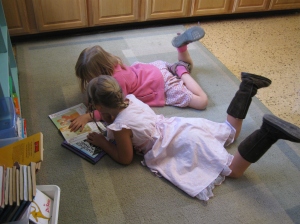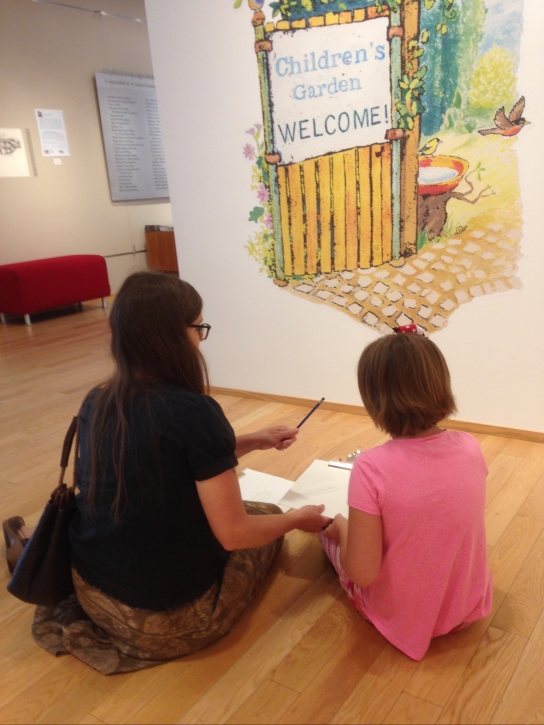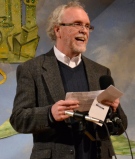
An experienced student helping a younger buddy read a book.
Follow the link below to my podcast titled Developmental Stages and Multiage Education.
http://k002.kiwi6.com/hotlink/sz195zeb7o/develop_appr.mp3
***************
The following is an enhanced transcript to my podcast on developmental stages.
Developmental Stages
It was once believed that children were simply new people that only lacked the knowledge of adults in order to be mature and wise. If this were really true, education would simply be the passing down of knowledge from one generation to the next. Now we understand that people think and reason differently during different stages of their lives. The way a child of three thinks is qualitatively different than the way a child of fifteen does. Further, as has been stated by Piaget, the stages that people pass through are followed in a sequential order, with none of the stages being skipped or followed in a different order (Ginn, 1995). Children from birth through eleven or more years of age go through four cognitive stages. Basically these stages show that the way children learn and make sense of the world changes from concrete manipulation to abstract manipulation of objects and information as they move through these stages.
Teachers strive to have all of their students be academically successful throughout their school years and beyond. This most often manifests itself through educators determining what it means to be a successful student and then trying to find ways to help diverse sets of students reach those expectations. Embedded within those expectations and driving many of the strategies employed by teachers is a knowledge of the cognitive stages of development as outlined above. However, when looked at from the students’ perspective, there is a different agenda of tasks that must be accomplished in order for the student to feel successful at different stages of their development. A study reported by James E. Gay, Robert B. Williams, and Joan B. Flagg-Williams found the following examples of developmental tasks.
1. Examples of developmental tasks of a girl in kindergarten included:
- Being accepted by adults.
- Dressing in ways pleasing to adults.
- Being accepted by a significant adult (e.g., teacher) outside of the home.
- Seeing herself as a contributing member of the class – helping other kids.
- Developing reading and writing skills.
- Speaking before the class.
- Developing relationships with peers/classmates.
- Developing socially acceptable ways of expressing her emotions rather than crying.
- Self-evaluation skills in relation to academics.
2. A second-grade boy’s developmental tasks were identified as:
- A desire to feel loved.
- Intending to improve his skills.
- Needing to have successful and rewarding school experiences.
- Developing appropriate coping mechanisms.
- Relating to and obtaining nurture from significant adults (e.g., teacher).
- Being able to tell people when he is hurting.
- Developing a relationship with his parents.
3. Some developmental tasks a sixth-grade girl was thought to be working on included:
- Academic survival -avoiding failure.
- Getting caught up in school work.
- Seeking positive attention.
- Attempting to please teachers.
- Gaining acceptance of peers.
4. An adolescent male’s developmental tasks were identified as:
- Establishing a personal and unique identity.
- Planning for his future education and work.
- Developing work habits.
- Collaborating with peers to establish a living arrangement away from his family.
(Gay, Williams, and Flagg-Williams, 1997)
When looked at together, these developmental tasks and the cognitive developmental stages discussed earlier can provide educators with a picture of child development as students pass through the school years. Although, as implied above, there are some general age spans that can be determined for each developmental stage, students often move through these stages at different rates. For instance, “…because gifted children often begin understanding and using concepts at an earlier age, they are said to be more adept at understanding and using abstraction” while they also seem to move more rapidly within and frequently between stages (Dalzell, 1998).
Developmentally Appropriate Educational Practices
What does this mean to educators? How can an understanding of cognitive developmental stages and developmental tasks help educators plan and implement a curriculum that is developmentally appropriate, one that helps insure student success and promotes life-long learning?
First of all a commitment to a child-centered (or student-centered) educational program is important. A child-centered program is one in which educators first strive to meet student needs. The antithesis of this would be a curriculum-centered approach which places the mastering of predetermined curriculum goals over that of meeting student needs (Stone, 1996). In order for a child to be successful, they need to meet the needs of their own developmental tasks. As they do this they will be grounded and ready to be engaged by a developmentally appropriate academic curriculum.
Because people think qualitatively different at different stages of their development, learning activities need to match the way each child successfully gains understanding and makes connections. In order for students to be actively engaged with their learning, the educator should assess their cognitive levels and determine their strengths and weaknesses. From this information the teacher should then individualize instruction as much as possible. Those students in the earliest developmental stages will need to manipulate real objects in ways that help them learn patterns and see connections. Students in later stages will need the chance to abstractly manipulate information and be given “…opportunities to communicate with one another, to argue and debate issues…to make mistakes and learn from them” (Ginn, 1995).
Although this looks as if the best educational structure would be to group students by developmental level, it is not. The work of Lev S. Vygotsky shows that there are other factors that need to be considered by educators when structuring classrooms and planning for instruction. A student’s “…actual developmental level refers to all the functions and activities that a child can perform on his own, independently without the help of anyone else. On the other hand, the zone of proximal development includes all the functions and activities that a child or a learner can perform only with the assistance of someone else. The person who intervenes in this scaffolding process could be an adult (parent, teacher, caretaker, language instructor) or another peer who has already mastered that particular function” (Guerra and Schütz, 2000). It is in this zone of proximal development, while social interaction is happening, that substantiative learning occurs. One way to effectively take advantage of this is to structure classrooms heterogeneously, to insure a diversity of skills and abilities. Since the boundary between any two developmental levels is not absolute and since a child can simultaneously exhibit traits from two different developmental levels, a heterogeneous mix of students will likely include children with developmental traits from two or more levels. When studying factors that make up exemplary programs for limited English proficient (LEP) students, researchers found that “…(m)ost sites emphasize cooperative learning in untracked classes, in which students with different proficiency levels work together in groups. The exemplary schools demonstrate the power of cooperative learning as a tool to unleash students’ ability to learn from one another. Some schools use practical strategies for keeping students with the same teacher(s) for several years. These students develop a sense of identity with their group; moreover the teachers are more easily able to coach them through their development as learners. Instead of placing students who lag behind in remedial classes, some schools assume that all students can learn to high levels and use an accelerated learning environment to get students on track quickly” (Berman, Minicucci, McLaughlin, Nelson, and Woodworth, 1995). These practices that work so well for students learning a new language also work well with students in any learning endeavor.
Just as structure looks different for developmentally appropriate practices, so do classroom lessons. The following list of learning activities are examples illustrating appropriate strategies for students at various developmental levels.
Primary – Teddy Bear Picnic http://www.teachers.net/lessons/posts/306.html
Primary aged students need to manipulate real world objects in order to learn. This mathematics lesson has kindergarten aged students physically grouping their own teddy bears based on attributes that they come up with (Pugh, 1997).
Intermediate – Seed Dispersal http://www.teachers.net/lessons/posts/110.html
This science lesson has elementary aged children create and test model seeds, comparing them to those found in nature. Children at this age need to make connections between the real and the abstract by observing and manipulating both. The way this learning activity requires students to look closely at real plant seeds and at the same time create mental abstractions that they turn into models, lends itself well to this developmental level (Kelly, 1997).
Secondary – Collaborative Poetry! http://www.teachers.net/lessons/posts/71.html
Secondary students generally can learn abstractly and are working on establishing their unique identity. This language arts learning activity, in which students collaboratively write poetry, lends itself to the developmental needs of this age group (Faulkner, 1997).
Other developmentally appropriate practices can be found in structures defined as multiage, nongraded, differentiated, and student-centered or child-centered. Whatever the label, educators striving to include developmentally appropriate practices as a part of their curriculum decisions should consider the following guidelines from the National Association for the Education of Young Children.
A. Developmentally appropriate curriculum provides for all areas of a child’s development: physical, emotional, social, linguistic, aesthetic, and cognitive.
B. Curriculum includes a broad range of content across disciplines that is socially relevant, intellectually engaging, and personally meaningful to children.
C. Curriculum builds upon what children already know and are able to do (activating prior knowledge) to consolidate their learning and to foster their acquisition of new concepts and skills.
D. Effective curriculum plans frequently integrate across traditional subject-matter divisions to help children make meaningful connections and provide opportunities for rich conceptual development; focusing on one subject is also a valid strategy at times.
E. Curriculum promotes the development of knowledge and understanding, processes and skills, as well as the dispositions to use and apply skills and to go on learning.
F. Curriculum content has intellectual integrity, reflecting the key concepts and tools of inquiry of recognized disciplines in ways that are accessible and achievable for young children, ages 3 through 8 (e.g., Bredekamp & Rosegrant 1992, 1995). Children directly participate in study of the disciplines, for instance, by conducting scientific experiments, writing, performing, solving mathematical problems, collecting and analyzing data, collecting oral history, and performing other roles of experts in the disciplines.
G. Curriculum provides opportunities to support children’s home culture and language while also developing all children’s abilities to participate in the shared culture of the program and the community.
H. Curriculum goals are realistic and attainable for most children in the designated age range for which they are designed.
I. When used, technology is physically and philosophically integrated in the classroom curriculum and teaching.
(National Association for the Education of Young Children, 1997)
Helping all students be successful during their school years by engaging them in a developmentally appropriate and student-centered program can insure their success as life-long leaners after they graduate. When a person views them self as a learner, understands that learning is a key to attaining their goals, and finds learning enjoyable, then they will seek out learning opportunities throughout their life. Developmentally appropriate practices in school can provide a foundation to support this.
Standards, High Stakes Testing, and Developmentally Appropriate Practices
All of this may lead one to wonder at the current trend in the United States to enact school reform through standards and accountability methods. This trend encourages a curriculum-centered rather than a child-centered approach to education. Current methods based on standards are the result of a three-pronged government approach to school reform. First are the creation of standards. These standards in many states have become the foundation to grade specific frameworks, detailed lists describing what academic skills a child should master at any particular age. Rarely do these frameworks allow for the reality of students who are differently-paced than the age level norm. The second part of the approach is to measure academic progress with standardized testing. These tests are either criterion referenced in which student scores are compared relative to a set standard deemed adequate for success, or they are norm referenced in which student scores are compared with other same-aged students who took the test. Although standardized testing may allow for success of the average developmental level of the students who are being tested, they do not necessarily allow for success of students whose developmental pace is different. The third part of this reform movement has to do with accountability. Consequences are created, both positive and negative, based on student test scores. It is this aspect that changes standardized tests from a tool that can inform instruction to high-stakes tests that can move schools away from child-centered approaches and towards curriculum-centered ones. “Increasingly … early childhood experts say, that (the solution to increasing a school’s scores) becomes that school’s need to downplay exploration, hands-on learning, and flexible curriculum to drill students in specific, structured academic content…’We’re comfortable with the idea that kids walk and talk at different ages, but we’re not comfortable with that happening with reading, writing, and arithmetic,’ says Gronlund. ‘It’s accountability that’s the crux of the problem, not standards'” (Harrington-Lueker, 2000).
 and that each student’s pace is not always constant. Children can at times learn quickly while at other times they will learn more slowly, similar to the physical growth spurts that occur during a student’s childhood. This varied pace can also fluctuate between subject areas as well as with passions for various subjects or areas of learning. While a student may be rapidly progressing in an area such as math during the first part of a school year, they may equally as likely show a relatively stagnate pace in reading comprehension during that same period of time, only to reverse this during a latter part of the year or during a subsequent year. This is one of the reasons many progressive schools use a multiage structure* throughout their program, it more easily supports students as they go through these natural fluctuations in learning pace and passions. Multiage educators further believe that the best way to support children, to best meet the students’ needs as they each follow their own academic growth spurts, is for assessment to be student- small group- and class-specific. To do this schools must treat teachers as professionals and rely on them create and use meaningful assessment strategies and materials – all guided by comprehensive curriculum maps, benchmarks, and of course the students themselves.
and that each student’s pace is not always constant. Children can at times learn quickly while at other times they will learn more slowly, similar to the physical growth spurts that occur during a student’s childhood. This varied pace can also fluctuate between subject areas as well as with passions for various subjects or areas of learning. While a student may be rapidly progressing in an area such as math during the first part of a school year, they may equally as likely show a relatively stagnate pace in reading comprehension during that same period of time, only to reverse this during a latter part of the year or during a subsequent year. This is one of the reasons many progressive schools use a multiage structure* throughout their program, it more easily supports students as they go through these natural fluctuations in learning pace and passions. Multiage educators further believe that the best way to support children, to best meet the students’ needs as they each follow their own academic growth spurts, is for assessment to be student- small group- and class-specific. To do this schools must treat teachers as professionals and rely on them create and use meaningful assessment strategies and materials – all guided by comprehensive curriculum maps, benchmarks, and of course the students themselves.
